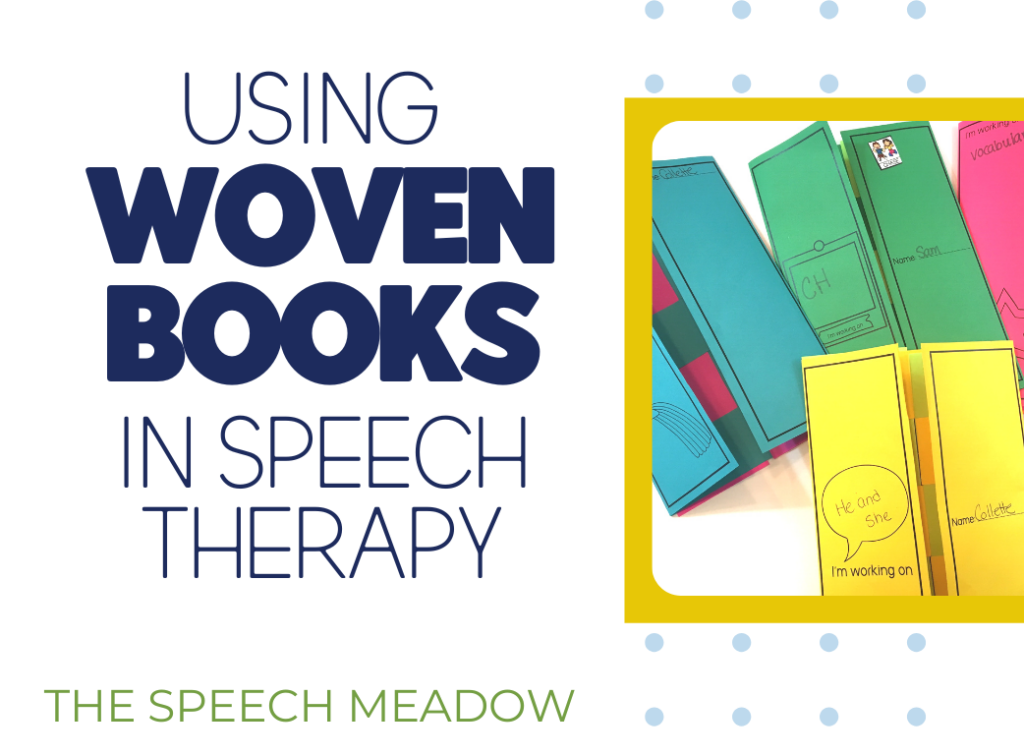I wish that I could take credit inventing this little gem, but I can’t. An Educational Assistant/Speech-Language Pathology Assistant showed me how to make these about ten years ago when I was just starting my journey as an SLP. I thought I would pass this along to you by showing how to make and use woven books in speech therapy.
This has been an invaluable tool not only for speech therapy but for language therapy as well. I have used these books in preschool; however, they are best for kindergarteners and older.
This has been an invaluable tool not only for speech therapy but for language therapy as well. I have used these books in preschool; however, they are best for kindergarteners and older.

How to Use a Woven Book:
1. As a craftivity: I will have the children make them on their own. They have to follow directions on how to fold, cut and weave the books. Then in one or maybe two sessions, they will decorate the book with images related to their goals. For example, If they are working on the “ch” sound, then they would either draw pictures of “ch” words, write them out or glue pictures onto the book, all the while having them practicing their sounds.
2. As a homework book: If the children are working on pronunciation goals, after each session, have students add one word to the book at the end of the session. I typically allow them to pick from a few words that they have been using successfully. At home, they practice all the words in their book. Sometimes I don’t send them home. I have students take them back to class and have their teacher or another staff member go through the book with them and practice their sounds/words/sentences throughout the week. I have done the same with vocabulary and grammar goals.
3. Vocabulary Dictionary: I have the children add the vocabulary words they have been working on to their book. If they have are able to, I have them add the definition of the word. This can be helpful if you are working on classroom vocabulary. The students can then refer back to the meaning of the word while in class. If they are working on language processing type goals, say similarities and differences, they put the words down and then write down they the are the same or different.
4. Grammar book: This is great for pronouns and verbing/tense type goals. If you are working on “he” and “she,” have the children draw or write out the pronouns at the top of the woven pages. Then have objects, verbs, etc… on the remainder of the pages. When practicing they will pick a word/picture and make a sentence using the correct pronoun.
5. Demonstration of progress: I will date the words, sentences, etc… that they add to the book. This way if they were working on artic goals, you could show them, parents, or school staff how they have progressed during therapy.
6. Help the children understand their goals: I have the children write out, or I will transcribe what they are working on the book. This allows us to talk about their goals.
How to Make the Woven Books:
1. Get two pieces of paper. You can print off the template if you like, you can find it here. You will need both pages to make a book. The second page will make enough strips for two books. I like to use two different colours. It makes the book pop.
2. Fold the first page in half with the writing on the outside.
3. Fold along the dotted lines inwards towards the middle.
4. Unfold the page and then fold it in half again.
5. Cut along the solid lines. The middle of your book should look like piano keys
6. Cut out the strips from the second page. You will need only two pieces to make a book.
7. Weave the strips from the second page into the middle of the book. You will need to weave each side of the book in opposite directions (i.e., one side of the book is woven out then in, and the other side of the book is woven in then out). This will allow the book to bend and split.
8. Refold all the book. Fold the middle seam both ways. This will allow the book to bend and split more easily. Do not glue the strips of paper together, you will not be able to fold the book correctly.
9. Have the children write out their goals and start adding to the book. For children who are older, have them write it out. For younger children, I will have them glue on pictures. I have used picture lists from Speech Therapy Plans. If you have students who like stickers, you can print these off on sticker paper and cut them out. That way they have functional stickers.
Here is a video on how to make woven books.
Would you make woven books in speech and what goals would you target? If you would like more speech therapy ideas, go here.

One Comment
Love this! I needed some fresh ideas that are quick, easy, inexpensive and hands on for kids!